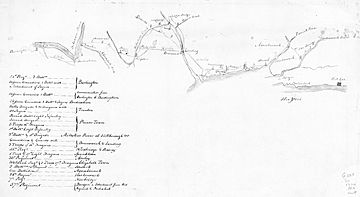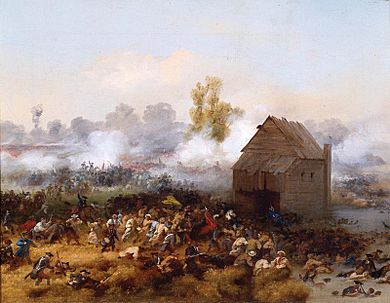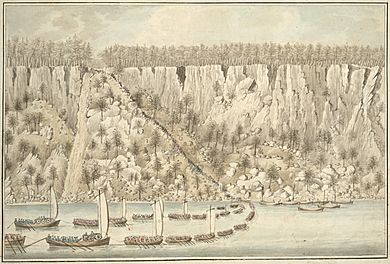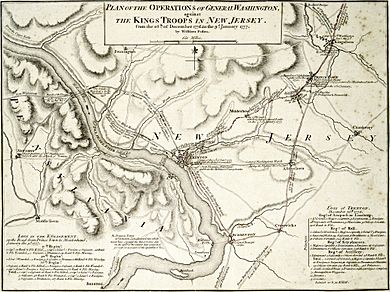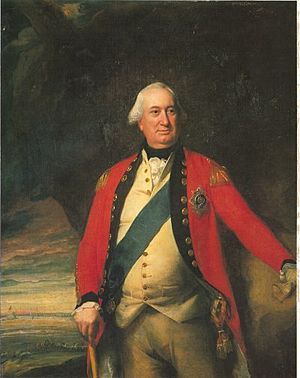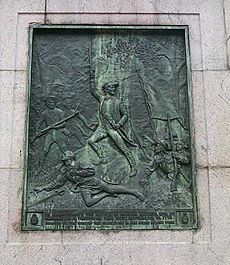New York and New Jersey campaign facts for kids
Quick facts for kids New York and New Jersey campaign |
|||||||
|---|---|---|---|---|---|---|---|
| Part of the American Revolutionary War | |||||||
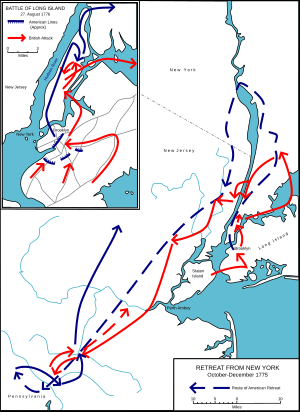 Map of the campaign |
|||||||
|
|||||||
| Belligerents | |||||||
|
|||||||
| Commanders and leaders | |||||||
| Strength | |||||||
| 23,000 soldiers and militia | 32,000 soldiers | ||||||
| Casualties and losses | |||||||
| 1,500 killed & wounded 4,000+ captured |
3,000 killed & wounded 1,400 captured |
||||||
The New York and New Jersey campaign was a series of important battles during the American Revolutionary War. These fights happened in 1776 and early 1777. The main goal was to control New York City and the state of New Jersey.
British forces, led by General Sir William Howe, fought against the American Continental Army, led by General George Washington. General Howe managed to push Washington's army out of New York. However, he spread his troops too thin in New Jersey. By January 1777, the British only held a few small areas near New York City. The British kept control of New York Harbor for the rest of the war. They used it as a key base for their operations.
Contents
The Start of the Campaign
The British army landed on Staten Island on July 3, 1776. They faced no resistance. This army included British soldiers and Hessian troops. Hessians were German soldiers hired by the British. General Washington's army had soldiers from New England and states as far south as Virginia.
In August, the British landed on Long Island. They defeated Washington's army in the Battle of Long Island. This was the largest battle of the war in North America. But the Continental Army managed to escape to Manhattan under the cover of darkness and fog. Washington faced more defeats in Manhattan. The only exception was a small win at Harlem Heights. He eventually moved his army to White Plains, New York. General Howe then went back to Manhattan. He captured American forces left there.
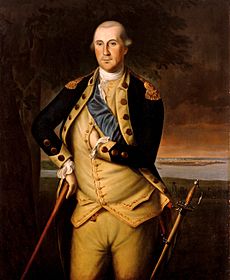
Washington and most of his army crossed the Hudson River into New Jersey. They then retreated all the way across the Delaware River into Pennsylvania. The American army got smaller. This was due to soldiers' enlistments ending, desertions, and low morale.
Winter Quarters and American Comeback
In December, General Howe ordered his troops into winter camps. They set up a line of outposts from New York to Burlington, New Jersey. Washington, however, planned a surprise attack. He launched a successful strike against the British at Trenton. This happened after he famously crossed the icy Delaware River. This victory greatly boosted American morale.
Because of this, Howe pulled his outposts back. They moved closer to New Brunswick and the coast near New York. Washington set up his winter camp at Morristown. Throughout the rest of the winter, both sides had many small fights. These were called the Forage War. The British were looking for food and supplies.
British Control of New York
Britain kept control of New York City and some nearby areas until the war ended in 1783. They used it as a base for other military actions. In 1777, General Howe launched a campaign to capture Philadelphia. He left General Sir Henry Clinton in charge of the New York area.
Meanwhile, General John Burgoyne tried to gain control of the Hudson River valley. He moved south from Quebec. But his plan failed at Saratoga. Northern New Jersey saw constant small battles between the two sides for the rest of the war.
Key Moments in New York City
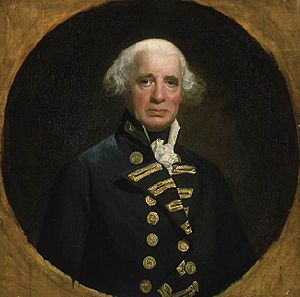
The Howe brothers, General William Howe and Admiral Lord Howe, were given power to try and make peace. On July 14, Admiral Howe sent a letter to "George Washington, Esq." Washington's aide politely said there was no one with that title in their army. Washington would only accept letters addressed to him as General. This showed that the Americans saw themselves as a separate nation.
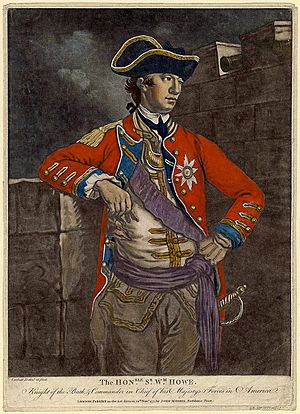
In late August, the British moved about 22,000 soldiers to Long Island. In the Battle of Long Island on August 27, the British surrounded the American positions. They pushed the Americans back to their forts. General Howe then started to attack the forts. But Washington cleverly led a nighttime retreat across the East River to Manhattan Island.
After this, Admiral Howe released General John Sullivan, who had been captured. Sullivan went to the American Congress. He told them the Howes wanted to talk peace. On September 11, the Howe brothers met with John Adams, Benjamin Franklin, and Edward Rutledge. This was called the Staten Island Peace Conference. But the two sides could not agree on anything.
Washington was worried his army might get trapped on Manhattan. He moved most of his army to Harlem Heights. He left 5,000 troops in the city. On September 15, General Howe landed about 12,000 men on lower Manhattan. They quickly took control of New York City. The Americans moved to Harlem. They fought a small battle there the next day and held their ground.
Howe tried to surround Washington again. He landed troops in Westchester County in October. Washington moved most of his army to White Plains. After a short battle on October 28, Washington retreated further north. A thick fog helped hide their movements from the British. This left American troops in upper Manhattan isolated. Howe returned to Manhattan and captured Fort Washington in mid-November. He took almost 3,000 American prisoners.
Four days later, on November 20, Fort Lee was also captured. This fort was across the Hudson River from Fort Washington. Washington moved much of his army into New Jersey. But the British quickly forced him to retreat again.
The American Army's Struggles
The situation for the American army looked very bad. Thomas Paine wrote, "These are the times that try men's souls." Washington's army had shrunk to fewer than 5,000 soldiers. Many enlistments were ending soon. Spirits were low, and support for the revolution was weakening. The Second Continental Congress even left Philadelphia, fearing a British attack.
Washington ordered more troops to join him. This included soldiers who had returned from a failed invasion of Quebec. He also ordered General Lee's troops to join him. Lee, however, was slow to move. On December 12, Lee was captured by the British. His command was then taken over by General John Sullivan. Sullivan marched the army to Washington's camp near Trenton.
The Trenton and Princeton Victories

Washington planned a surprise attack on the British at Trenton. On the night of December 25–26, 1776, Washington and 2,400 men secretly crossed the Delaware River. They surprised the Hessian soldiers the next morning. They killed or captured nearly 1,000 Hessians. This victory greatly boosted the army's morale.
This win also made British General Lord Cornwallis leave New York. He gathered an army of over 6,000 men. He marched them towards Washington's position south of Trenton. Cornwallis left 1,200 soldiers at Princeton. He then attacked Washington's position on January 2, 1777. He was pushed back three times before nightfall.
During the night, Washington secretly moved his army again. He went around Cornwallis's army. His goal was to attack the British soldiers at Princeton. On January 3, American soldiers fought British troops from Princeton. In the Battle of Princeton, the Americans won. The British lost more than a quarter of their force. American morale rose even higher. This period, from December 25, 1776, to January 3, 1777, is known as the Ten Crucial Days.
These defeats convinced General Howe to pull most of his army out of New Jersey. He only left small outposts at New Brunswick and Perth Amboy. Washington set up his winter camp at Morristown. He had taken back most of New Jersey from the British.
After the Campaign
The British gained control of New York Harbor and the nearby farming areas. They held New York City and Long Island until the war ended in 1783. The Americans lost many soldiers and supplies. But Washington managed to keep his main army together. He avoided a final battle that could have ended the war. With the bold wins at Trenton and Princeton, he gained back momentum and boosted morale. The areas around New York City remained battlegrounds for the rest of the war.
News of Washington's successes reached Paris. This was important because France was secretly helping the Americans. The French were very happy with the news. This made their diplomatic position stronger.
What Happened Next
The British planned two big operations for 1777. One was to control the Hudson River valley. This plan failed, and General Burgoyne's army surrendered at Saratoga, New York. The other plan was General Howe's attempt to take Philadelphia. This succeeded in September.
Washington's strategy in 1777 was mostly defensive. He could not stop Howe from taking Philadelphia. But he did send help to General Horatio Gates. Gates was defending against Burgoyne's army. After Burgoyne's defeat, France officially joined the war on the American side.
Legacy of the Campaign
Today, there are plaques and memorials in New York City, Brooklyn, The Bronx, Westchester, and Trenton. These remember the battles that happened there. The Princeton Battlefield and Washington's Crossing are important historical sites. State parks also protect parts of these battle locations. Morristown National Historical Park preserves the areas where the Continental Army camped in winter.
See also
 In Spanish: Campaña de Nueva York y Nueva Jersey para niños
In Spanish: Campaña de Nueva York y Nueva Jersey para niños


